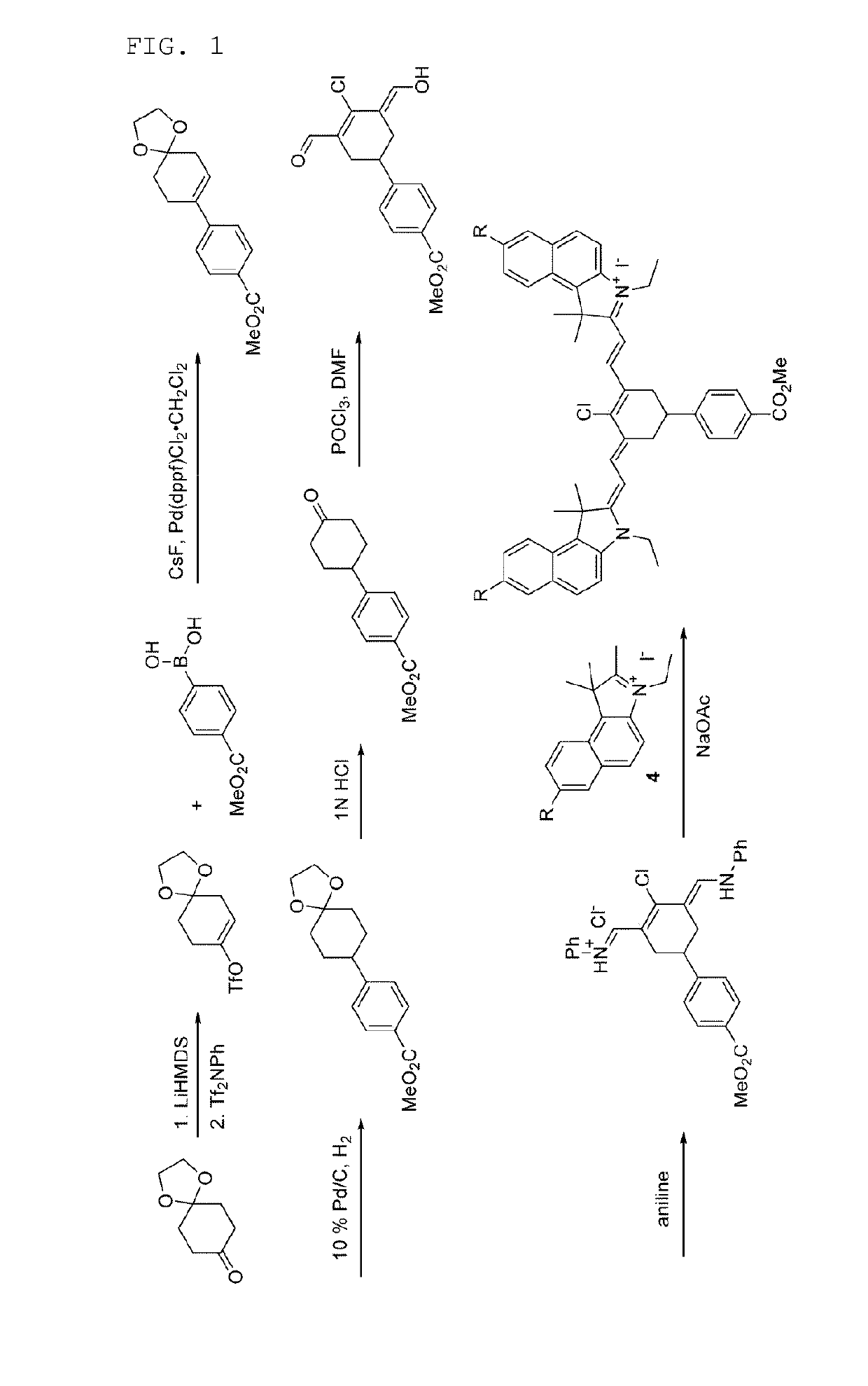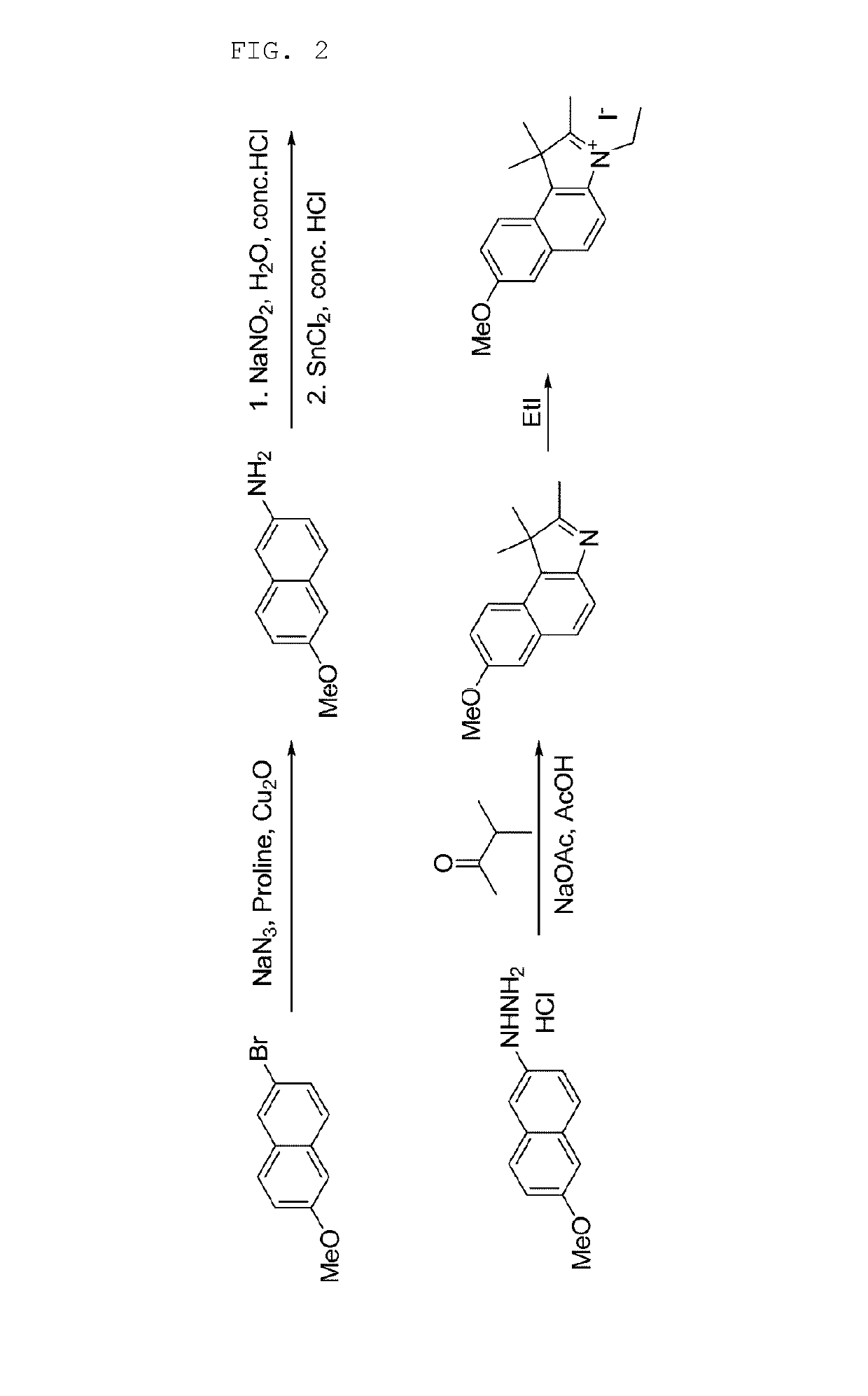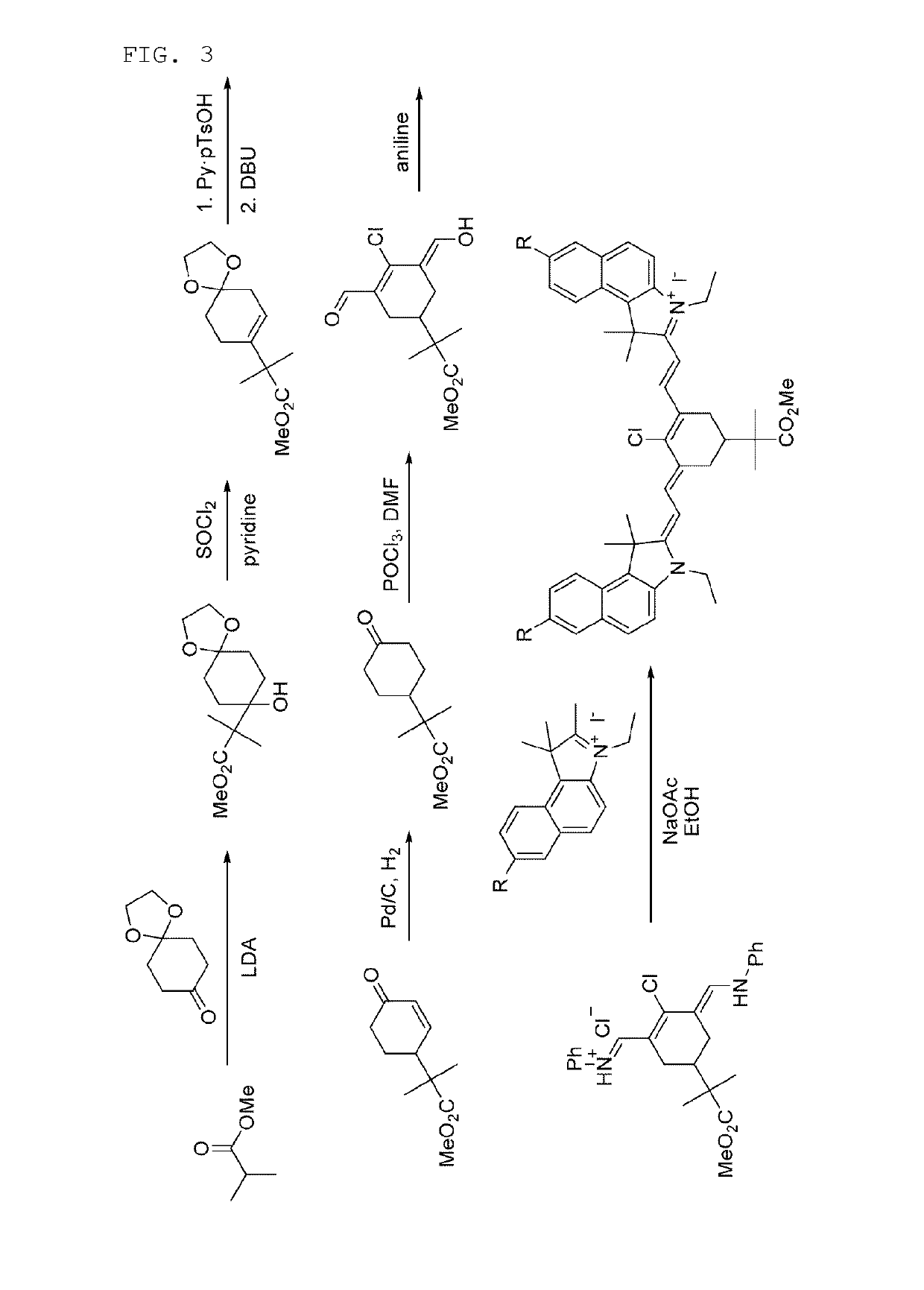Organic compound, near-infrared fluorescent constant medium containing same, and method for nano-granulating constant medium
a fluorescent constant and organic compound technology, applied in organic chemistry, chemistry apparatus and processes, metal/polymethine dyes, etc., can solve the problems of inconvenient testing subject radiation and electromagnetic waves, long measurement and diagnosis time, and conventional imaging diagnostic methods that require complex manipulations. , to achieve the effect of improving the detection accuracy, improving the detection accuracy and reducing the number of errors
- Summary
- Abstract
- Description
- Claims
- Application Information
AI Technical Summary
Benefits of technology
Problems solved by technology
Method used
Image
Examples
example 1
2-((E)-2-((E)-2-chloro-3-((E)-2-(3-ethyl-1,1-dimethyl-7-sulfo-1H-benzo[e]indo-1-2(3H)-ylidene)ethylidene)-5-(4-(methoxycarbonyl)phenyl)cyclohex-1-enyl)vinyl)-3-ethyl-1,1-dimethyl-1H-benzo[e]indolium-7-sulfonate
[0091]
1-1: Synthesis of 1,1,2-trimethyl-1H-benzo[e]indole-7-sulfonic acid
[0092]
[0093]A mixture of 1,1,2-trimethyl-1H-benzo[e]indole (1.00 g, 4.78 mmol) and sulfuric acid (3.69 ml, 69.3 mmol) was stirred at 140° C. for 1 hour. After the stirred solution was cooled to room temperature, an ice-water mixture was added thereto, and the mixed solution was adjusted to pH 3 using an aqueous solution of 6 N NaOH. The generated solid was filtered and then washed with water and Et2OH. The obtained solid was dried in vacuo to give a white solid of 1,1,2-trimethyl-1H-benzo[e]indole-7-sulfonic acid (682 mg, 2.36 mmol, 49.3%).
[0094]1H-NMR (DMSO-d6, Varian 400 MHz): δ1.63 (6H, s), 2.62 (3H, d, J=6.4 Hz), 7.78 (1H, d, J=8.4 Hz), 7.87 (1H, d, J=8.4 Hz), 8.14-8.18 (1H, m), 8.21 (1H, d, J=8.8 Hz)...
example 2
7-bromo-2-((E)-2-((E)-3-((E)-2-(7-bromo-3-ethyl-1,1-dimethyl-1H-benzo[e]indol-2(3H)-ylidene)ethylidene)-2-chloro-5-(4-(methoxycarbonyl)phenyl)cyclohex-1-enyl)vinyl)-3-ethyl-1,1-dimethyl-1H-benzo[e]indolium iodide
[0118]
2-1: Synthesis of 7-bromo-3-ethyl-1,1,2-trimethyl-1H-benzo[e]indolium iodide
[0119]
[0120]A mixture of 7-bromo-1,1,2-trimethyl-1H-benzo[e]indole (300 mg, 1.04 mmol) dissolved in acetonitrile (1 ml), and iodoethane (0.252 ml, 3.12 mmol) was heated at 90° C. for 11 hours. After the reacted solution was cooled to room temperature, the generated solid was filtered, and then washed with acetonitrile and Et2O to give a gray solid of 7-bromo-3-ethyl-1,1,2-trimethyl-1H-benzo[e]indolium iodide (343 mg, 0.772 mmol, 74.2%).
[0121]1H-NMR (DMSO-d6, Varian 400 MHz): δ1.50 (3H, t, J=7.2 Hz), 1.75 (6H, s), 2.93 (3H, s), 4.61 (2H, q, J=7.2 Hz), 7.88 (1H, d, J=8.8 Hz), 8.23 (1H, d, J=9.2 Hz), 8.30 (1H, d, J=8.8 Hz), 8.36 (1H, d, J=9.2 Hz), 8.55 (1H, s).
Synthesis of 2-2.7-bromo-2-((E)-2-((E...
example 3
2-((E)-2-((E)-2-chloro-3-((E)-2-(3-ethyl-7-methoxy-1,1-dimethyl-1H-benzo[e]indol-2(3H)-ylidene)ethylidene)-5-(4-(methoxycarbonyl)phenyl)cyclohex-1-enyl)vinyl)-3-ethyl-7-methoxy-1,1-dimethyl-1H-benzo[e]indolium iodide—See Synthesis Schemes 1 and 2
[0125]
3-1: Synthesis of 6-methoxynaphthalene-2-amine
[0126]
[0127]After 2-bromo-6-methoxynaphthalene (200 mg, 0.844 mmol), sodium azide (110 mg, 1.69 mmol), proline (126 mg, 1.10 mmol), and copper(I) oxide (121 mg, 0.844 mmol) were added to degassed DMSO (1.7 ml), this mixture was heated at 100° C. for 11 hours. The reacted solution was cooled to room temperature, and then ethyl acetate and water were introduced thereto. The mixed solution was filtered to remove solid, and then the filtered liquid was layer-separated. The separated organic layer was washed with an aqueous solution of saturated sodium bicarbonate, dried over sodium sulfate, and then concentrated in vacuo. The concentrated solution was purified by silica gel column chromatograph...
PUM
| Property | Measurement | Unit |
|---|---|---|
| size | aaaaa | aaaaa |
| emission wavelength | aaaaa | aaaaa |
| emission wavelength | aaaaa | aaaaa |
Abstract
Description
Claims
Application Information
 Login to View More
Login to View More - R&D
- Intellectual Property
- Life Sciences
- Materials
- Tech Scout
- Unparalleled Data Quality
- Higher Quality Content
- 60% Fewer Hallucinations
Browse by: Latest US Patents, China's latest patents, Technical Efficacy Thesaurus, Application Domain, Technology Topic, Popular Technical Reports.
© 2025 PatSnap. All rights reserved.Legal|Privacy policy|Modern Slavery Act Transparency Statement|Sitemap|About US| Contact US: help@patsnap.com



